By Kim Gray
As we drive along the Icefields Parkway en route to Jasper, Alberta, we feel like we’re quite literally road-tripping into the arms of nature.
The famous highway is flanked with sunny buttercups, pink fireweed and ruby red paintbrush. Glacier-fed lakes and rivers dazzle us with impossible blues. And just when the mountains can’t get more dramatic, they surprise us — growing in size and scope with every kilometre we travel.
We happily share the road with a handful of canoe-toting cars and dilly-dallying RVs sporting names like Serenity, Sunrise and Spirit. The truth is, we’re all after the same thing: fresh air, wide-open spaces and a wilderness experience where we can safely (pandemic and all) rejuvenate with our nearest and dearest.
Enter Jasper National Park — the largest and one of the most spectacular national parks in the Canadian Rockies, a year round destination for outdoor enthusiasts of all kinds and home to some of the most exceptional wildlife viewing this country has to offer.
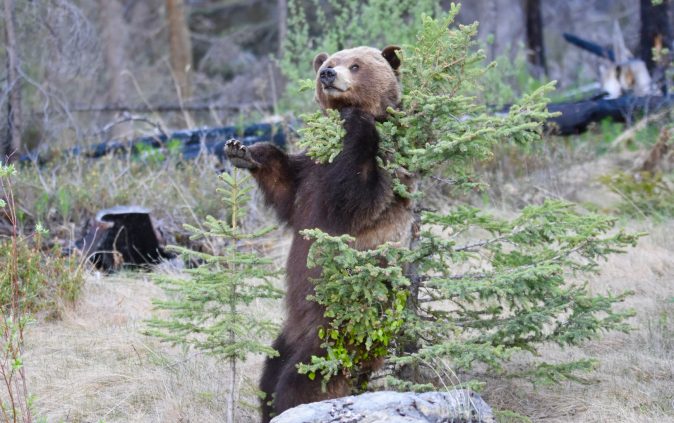
Grizzly bear in Jasper National Park / Photo (taken with a zoom lens) courtesy Alpine Village Cabin Resort guest Britta Wilke
When we arrive at Jasper’s townsite — armed with a rollicking, nature-inspired itinerary courtesy of Tourism Jasper — we promptly check into Alpine Village Cabin Resort, our accommodations for the next two nights, with a final evening at Fairmont Jasper Park Lodge. The resort, located beside the frothy turquoise waters of the Athabasca River, boasts 55 cabins designed to provide visitors with a “home away from home” experience.
“Our guests just love them,” says general manager Cassi Allin, whose family has owned the resort for 35 years. “We get wildlife photographers who come, sometimes in the spring and again in the fall, and their excitement for Jasper and the animals that live here always recharges us. This is a pretty special place.”
After settling into our cozy cabin, and with hopes of eventually catching a glimpse of Jasper’s legendary wildlife ourselves, we meet with Brian Catto, a personal interpretation coordinator with Jasper National Park who takes the idea of the region as a special place to another level.
“This area is ancient. We’re essentially sitting on a half-a-billion-year-old sea bed that, thanks to plate tectonics, became the mountains that you see all around you,” Catto explains, adding that the 11,000 square kilometre national park is also a UNESCO Canadian Rocky Mountain Parks World Heritage Site. “That 500 million years of history means the fossils found here give us glimpses into how life on earth has evolved.”
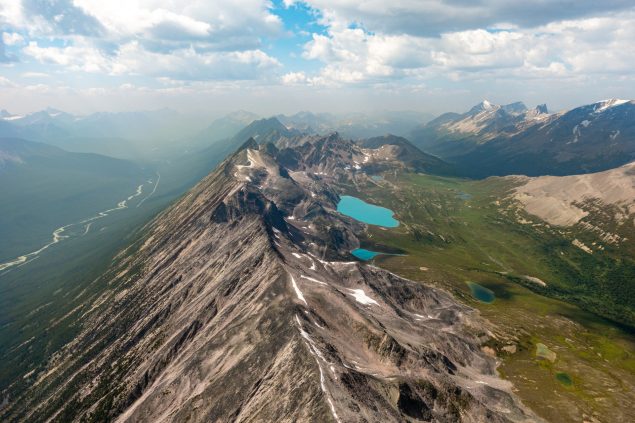
Photo courtesy Tourism Jasper
Later that night, we dine (and quench our thirst) at Jasper Brewing Company before hitting the Jasper Planetarium for a presentation about the park’s Dark Sky Preserve — a designation given by the Royal Astronomical Society of Canada in 2011 and celebrated every October during the town’s annual Dark Sky Festival.
If the ancient geography of this part of the world wows us, so, too, does the region’s star-speckled night-time sky. After the show, humbled by humanity’s place in the universe, we return to our little cabin in the woods for a solid night’s sleep.
The next morning, we fuel the day’s upcoming adventures with a hearty breakfast, including overnight oats laced with whiskey and coconut milk, at Coco’s Cafe.
First up is a tour with an enthusiastic Maligne Adventures guide who escorts us and a handful of other Canadian visitors to Medicine Lake, the waterfalls of Maligne Canyon and the shores of Maligne Lake where we take a cruise to Spirit Island.
We already knew that the Spirit Island location (see our lead photo) would be stunning given the images we’ve seen previously, but we aren’t prepared for the wonder we feel when we visit in person. Given the region’s history, Matricia Brown of Jasper’s Warrior Women says our reaction shouldn’t surprise us.
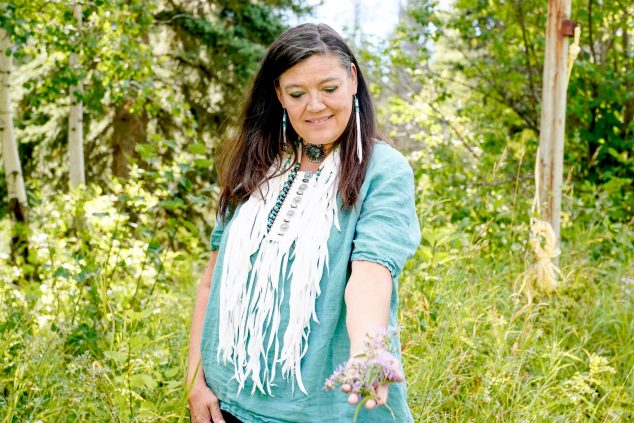
Warrior Women’s Matricia Brown / Photo courtesy Tourism Jasper
“People have found arrowheads in Jasper that date back almost 8,000 years — way older than the pyramids of Egypt or the Roman Empire,” says Brown, a member of the Sturgeon Lake Cree Nation who offers transformative cultural experiences to travellers and locals alike that include fireside chats, plant walks and moccasin workshops.
More than 30 Indigenous groups are said to have ties to Jasper National Park, she says, adding: “There is a rich cultural history here, so when people say there’s something special about Jasper, well, that feeling’s been here for a really long time, which is why it feels sacred.”
We cap our full day with a Jasper Food Tours “Peak-Nic” — a delightful concept invented by owner Estelle Blanchette that involves hiking 3.8 kilometres to a lookout point at sunset.
With Jasper’s townsite far below and mountains all around us, we take a lesson in backcountry cooking. Blanchette, our lively culinary lead, assists as we prepare and then devour a yummy feast of chili, naan bread and chai tea.
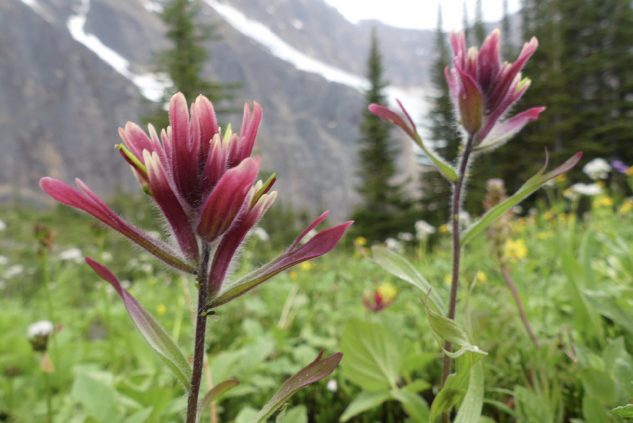
Edith Cavell Meadows Trail in Jasper National Park / Photo by T&C
The following day, we meet Christian Roy of Canadian Skyline Adventures who escorts us to Edith Cavell Meadows Trail for a day hike that gives back with wildflowers galore and a stunning vista of the Angel Glacier.
Roy is a calm, competent guide who also, we’re interested to hear, leads small groups on overnight trips into the backcountry.
To our delight, two fat-bottomed hoary marmots, the largest in North America’s ground squirrel family, make an appearance near the trail; they perch as still as statues on an outcrop high above us like Rocky Mountain royalty. Their snouts look as if they’ve been dipped in vanilla milkshakes and it’s sweet to see them.
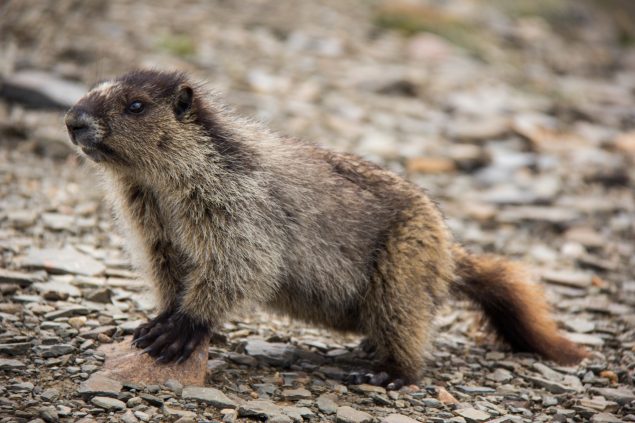
Hoary marmot in Jasper National Park / Photo by Ryan Bray courtesy Parks Canada
It turns out, I’m not the only one who appreciates hoary marmots. Phillipa Gunn, a wildlife guardian with Jasper National Park, would later confess to me that they’re her favourite animal in the park. “I like that they whistle and that they camouflage well in their environment. There’s something endearing about them,” says Gunn.
She appreciates that we kept a respectful distance from the animals when we saw them, as tempting as it was to climb closer for a better photograph.
“We have a restricted activity order in place that requires visitors to maintain their distance from wildlife in general,” says Gunn. She refers to Parks Canada guidelines that require people to stay at least 100 metres away from bears, cougars and wolves and 30 metres away from elk, moose, caribou, sheep and goats.
The wildlife guardian’s job is to share information like this with park visitors to ensure safe and enjoyable viewing practices for all involved.
Even we’ve noticed that some travellers “leave their brains in the car” (as someone told us recently) when they see animals in the wild, breaking all the rules for successful human-wildlife coexistence — rules like “stay in your vehicle if you see wildlife when you’re driving, don’t feed wildlife, give wildlife space and be aware that you’re responsible for your own safety.”
Gunn says guests in Jasper National Park have recently been able to respectfully observe a moose and her calf spending time near the boat house at Maligne Lake. And not long ago, she continues, visitors were able to safely watch a grizzly and her two cubs feed on an elk carcass over the course of a week.
“It’s a privilege and a joy to watch people have positive wildlife experiences in the park,” she says. “These are memorable moments that I’m sure encourage visitors to care more about nature into the future.”
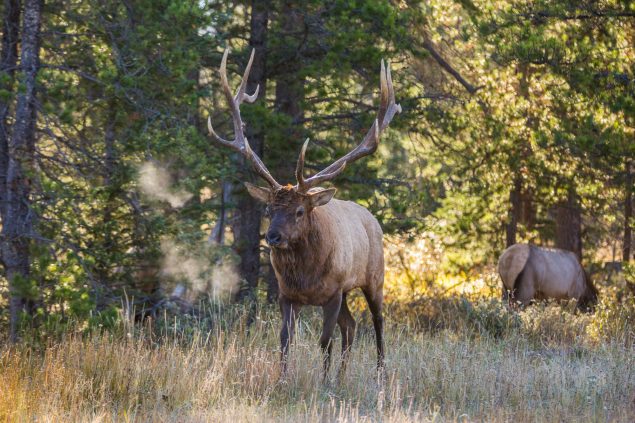
Elk during the fall rut in Jasper National Park / Photo by Ryan Bray courtesy Parks Canada
On our last night in Jasper we enjoy a memorable meal at Tekarra Restaurant — memorable, yes, for an outstanding charcuterie board, but also for the herd of female elk that casually wanders past the restaurant’s windows.
Afterwards, as we make our way back to our accommodations at the historic Fairmont Jasper Park Lodge, we pass by a young bull elk wrestling a small tree to the ground with his giant antlers.
It’s rutting season and I’m told he could be doing this for several reasons: looking for an outlet for his raging hormones, scenting the tree, trying to remove the velvet from his young antlers or all of the above.
We pull over and stop the car to watch him from afar. I’ve never seen anything like it. The energy and power of this young animal is nothing short of magnificent. The tree doesn’t stand a chance. We could stay and watch for hours but we move on so others can also observe him.
We tuck in at the lodge, still buzzing from our bull elk sighting, for our last night in Jasper with a view of Lac Beauvert. The next morning, we rise to the sound of loon calls (of course) and, before we check out, we visit the hotel’s Mountain Galleries for a leisurely tour of Canadian landscape art.
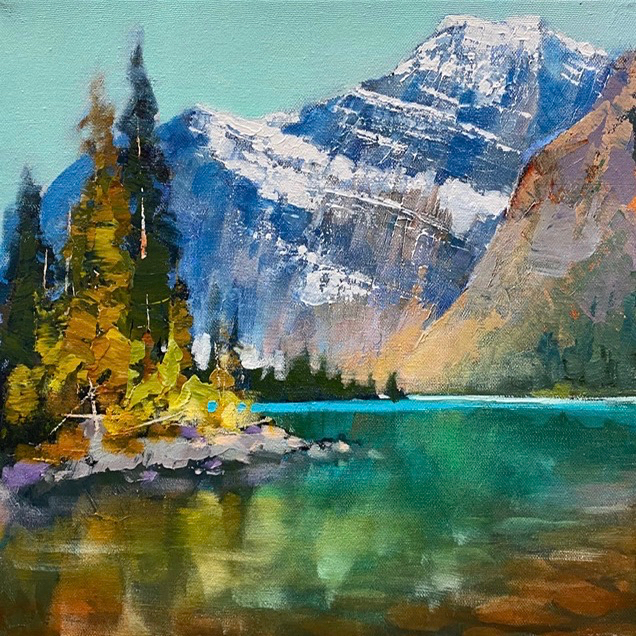
“Snow on Cavell Lake” by Linda Wilder courtesy of Mountain Galleries
Owner Wendy Wacko tells us that her gallery’s paintings are sold and shipped all over the world.
“Given the times, art, and the idea of connecting to nature even when you’re indoors, has never been more important,” says Wacko. “There’s an energy that comes from original art that you just can’t replicate.”
I’m excited to see that one of her artists, Linda Wilder, creates work that captures the intoxicating blues of Rocky Mountain rivers and lakes that I love so much.
Final stop before our departure? Jasper Yellowhead Museum and Archives, a great resource for anyone interested in diving deeper into the region’s rich history, where we see everything from exquisitely beaded Métis moccasins to storied canoes.
We begin our drive home beneath a sky full of dreamy, swirling clouds that make me think of Italian marble. The mountain views along the Icefields Parkway are, once again, breath-catching. We stop several times along the way for more photos.
At one point, the song “Wild Thing” (…you make my heart sing) pops up randomly on our playlist. Fitting, I think with a smile, given our recent wilderness immersion.
We’re feeling pretty relaxed, even restored, and why wouldn’t we be? We just threw ourselves into the arms of nature and she hugged us right back.
Note from editor: This post was powered by Jasper National Park and Tourism Jasper. We’re grateful to our partners in travel throughout Canada who help keep us paddling forward.
Founded by two Canucks on the loose in a big country, Toque & Canoe is an award-winning Canadian travel blog. Follow us on Twitter, Instagram and Facebook


Nat Gillis commented:
Makes me want to head up and enjoy more of Jasper! Thanks for sharing.
toque & canoe commented:
What’s stopping you Natalie? 🙂 We’d love to see your photographic take on JNP. We’ll be watching for it. T&C
Nancy Burger commented:
One of my favourite national parks! It is so worth a canoe trip to the far end of Maligne, PAST the commercial Spirit Island boats! Wonderful camping, fishing and hiking at the far reaches of the lake! So many more places to explore in this region- you missed the Miette Hot Springs, the Miette Canyon, Pyramid Lake, Mt. Edith Cavell, The Alpine Club Hut at Outpost Lake, Amethyst Lakes, Arrow Lake, and on and on! Come back to spend a week or two‼️‼️‼️
toque & canoe commented:
Hi Nancy. Thanks for your comment! We’ve canoed Pyramid Lake before and it was fabulous and if you read our story, you’ll see that we hiked Edith Cavell Meadows. But these are all great ideas so we’ll jot them down for our next round. Cheers! T&C
Margo commented:
Love Jasper. Had the privilege of visiting during last fall’s amazing Dark Sky Festival. Such a lovely tight-knit community makes you feel so welcome and the restaurants are great too! And in mid-winter the uncrowded skiing at Marmot Basin is a real treat. One of my favourite places in Canada.
toque & canoe commented:
We’re with you Margo, pretty special place! Thanks for your comment and hope to see you out West one day soon. T&C